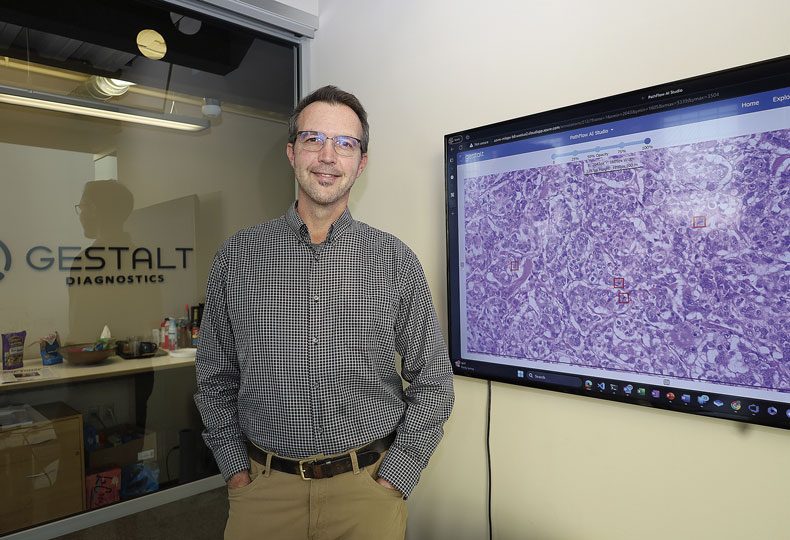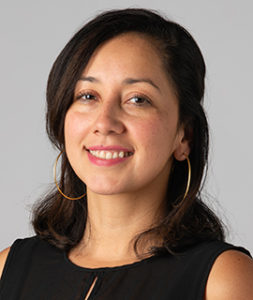
Gestalt Diagnostics launches cancer-grading tool
Algorithm designed to save time for pathologists

Brian Napora, vice president of AI innovations at Gestalt Diagnostics LLC, says the company’s new tool was trained on datasets from more than 280,000 annotations from pathologists.
| Karina EliasGestalt Diagnostics LLC has launched an artificial intelligence-assisted algorithm that can be used to aid pathologists in grading and classifying eight types of cancers through mitotic counting, says Brian Napora, vice president of AI innovations at the Spokane-based tech company.
Mitotic counting is a method used by pathologists to grade the severity of a cancer once a type has been identified. A pathologist will take a tissue sample, view it under a microscope, and count the number of mitoses, or cell divisions, per high power field, he says.
Breast cancer, for example, has three distinct scales used by pathologists, says Napora. If there are under seven mitosis occurrences in a certain field of view under 10-power magnification, then that is graded as stage 1; if there are between eight and 15, that is graded as stage 2; and more than 15 is stage 3.
The mitotic counting algorithm was trained on datasets from over 80,000 pathologists’ annotated mitotic figures and over 200,000 nonmitotic, yet “lookalike” figure annotations. The importance of having lookalike annotations is to train the algorithm to differentiate between negative lookalikes of mitosis and genuine mitosis, he says.
The mitotic count is for use on cutaneous mass cell tumors, breast cancer, lymphoma, lung cancer, melanoma, neuroendocrine tumors, colon cancer, and bladder carcinoma, he says.
“What we’re able to do is highlight what the algorithm thinks is mitosis, and then display that for a pathologist in a visual manner that really focuses their attention,” says Napora.
Gestalt CEO Dan Roark says the work the company is doing with AI development resonates with customers because of its added efficiency in providing cancer diagnoses.
“It’s very enlightening for that data to be provided to them quickly,” he says. “We’re essentially highlighting the cancer hot spots and enabling pathologists to see the margins where there is no cancer.”
In addition to assisting pathologists with their diagnoses, Napora says the company chose to create a mitotic counting algorithm because research indicates that 15 to 20 minutes can be saved on a typical case where mitosis is being counted for cancer classification and grading.
“That translates into more cases that can be read by a pathologist and faster turnaround times for patients,” he says.
The savings in time is especially important in pathology, where the number of medical doctors entering pathology as a discipline is declining, says Napora.
As previously reported by the Journal, pathologists are in short supply worldwide in general and in the U.S. specifically, where the average age of pathologists is about 60.
According to a report in Pathologist Magazine, there are 13.2 million medical doctors, including over 102,000 pathologists worldwide. In the U.S. and Canada, there is one pathologist for every 50 medical doctors. Seventy percent of pathologists are concentrated in just 10 countries, including the U.S., the United Kingdom, Japan, and China.
“Pathology is used in cancer diagnosis and is kind of the primary diagnostic tool,” says Napora. “One of the solutions has been to use technology to leverage fewer pathologists for more cases. If you can reduce turnaround times by 15 minutes per case, that’s one small contributor.”
Gestalt Diagnostics was established in 2017 with the vision of helping pathologists by providing them with the technology and services that enable them to diagnose diseases faster and more efficiently. The company’s offices are on the first floor of the SIERR building, at 850 E. Spokane Falls Blvd., in Spokane’s University District. Roark says Gestalt has 25 employees spread out here and in Boise, Idaho; Los Angeles; San Francisco; and Boston. Currently, the company has between 35 and 40 customers that include large health care providers, pathology laboratories, and medical schools, he adds.
Gestalt is a spinoff of Spokane-based Inland Imaging LLC. In 2017, Gestalt received an accumulated $2.6 million in financing from Inland Imaging Investments Inc., Inland Imaging PS, angel investment fund Kick-Start III, and the Spokane Angel Alliance.
Roark declines to disclose Gestalt’s projected annual revenue.
Pathworkflow, the company’s first product offering, is software that was developed to reduce the time it takes to review pathology samples. Created in collaboration with Spokane-based information technology company, Nuvodia LLC, Pathworkflow is capable of creating digital scans of pathology samples, enabling pathologists to review samples more quickly as well as download and share them with their colleagues.
For the last 100 years, pathology has been done through the traditional histology process of receiving a surgical specimen, slicing it, putting it on a glass slide, staining it with a number of biomarkers, and viewing it under a microscope, says Napora. For the last 20 years, there’s been a growing movement toward digitization, he adds. Gestalt has added the digital aspect of that process by scanning those slides on high-resolution scanners and consolidating the different scanner output types into a single format, he says.
“AI is a subsection of image analysis,” says Napora, adding that some facets of computer-assisted analysis of images have been conducted for decades.
The purpose of mitotic detection is that it’s one of many tools used in grading cancer, he says. Various types of cancer require counting the occurrence of mitosis—the process by which a cell will eventually divide into two distinct cells—in a region of interest in the tissue, he says.
Pathologists spend years training to identify regions of interest in tissue samples, he says.
“They see it very differently than you and I,” Napora says. “That is where their gestalt—that’s where we get our name from—their base knowledge is so much different than ours that they see that differently.”
A pathologist’s gestalt, a German word generally meaning the whole is greater than the parts, takes years of training to identify these small details in tissue samples, he adds. AI and machine learning can help focus the pathologists on a region of interest, he says.
“With this type of technology, we’re able to take the skill of a 20-year veteran and provide that as a tool for a first-year resident,” he says.
Gestalt Diagnostics obtained mitotic annotation datasets from publicly available domains, as well as from the patients of customers who agree to clinical research, says Napora. The dataset used covers seven tissue types across eight tumors and is digitized with seven scanner models.
Roark says that the company’s customers see the value in creating custom AI algorithms that allow them to enhance their work.
“They want to lean in and see the value in what we’re building,” he says.




